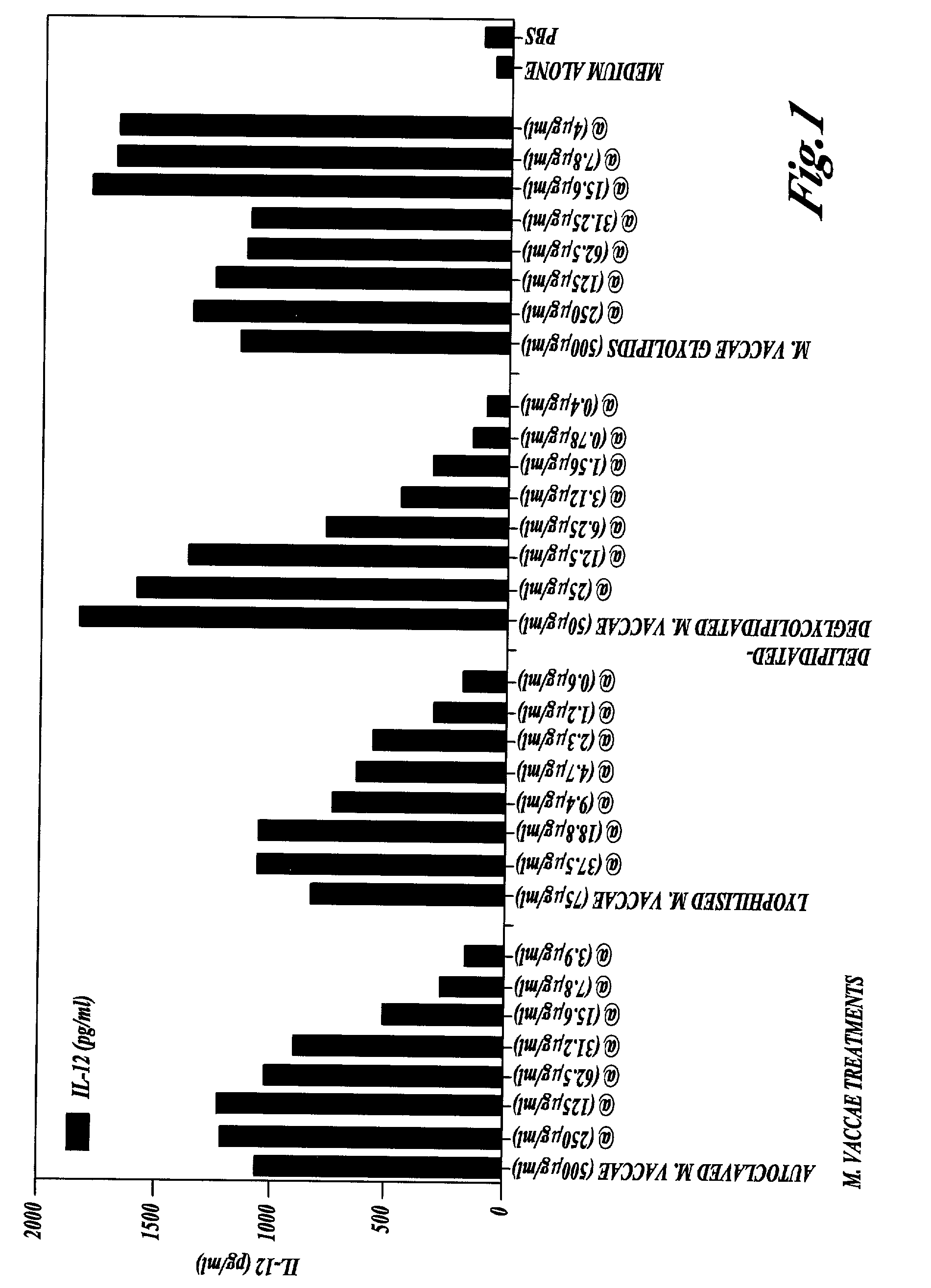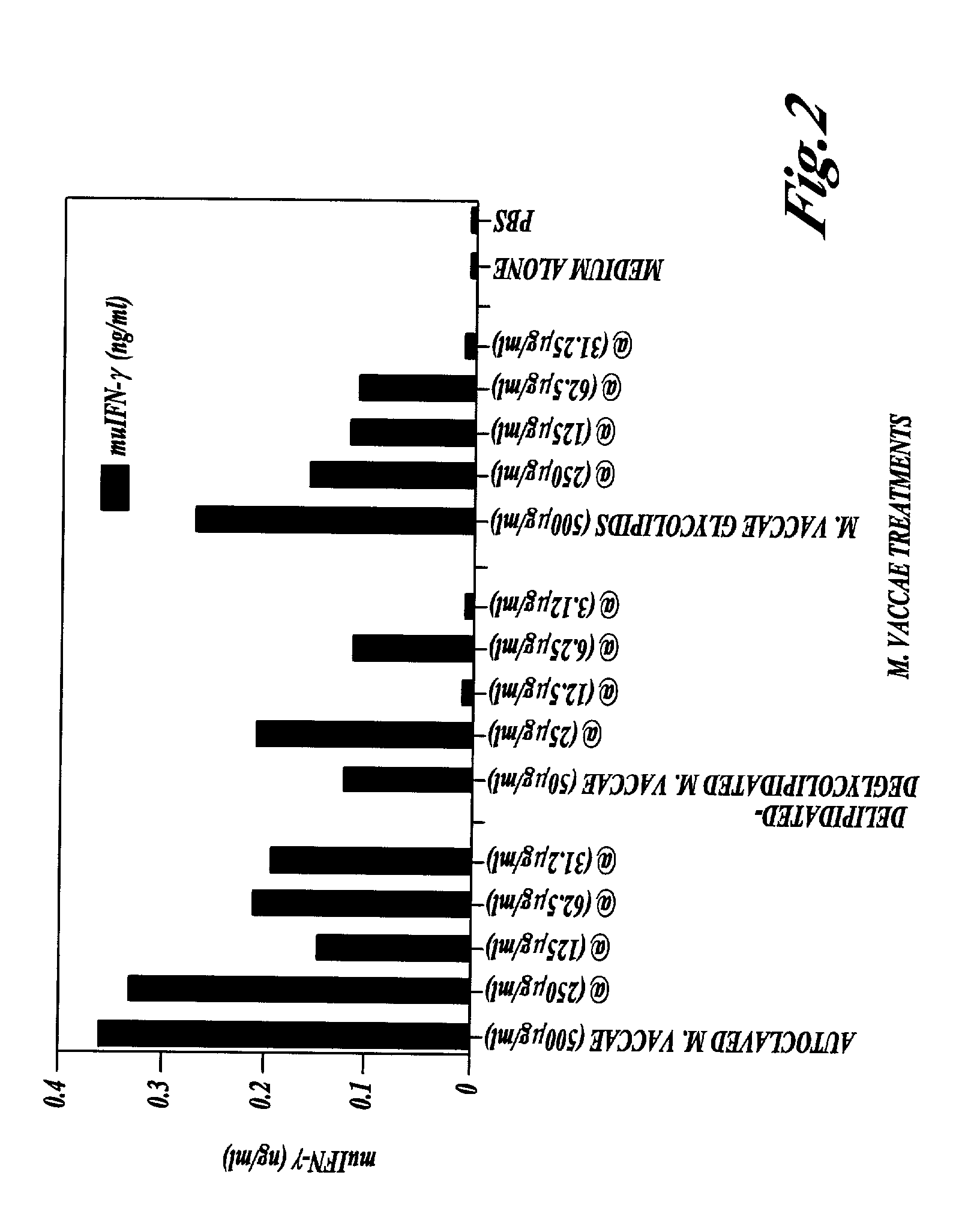Methods and compounds for the treatment of immunologically-mediated skin disorders
a skin disorder and immunologically-mediated technology, applied in the field of immunologically-mediated skin disorders, can solve the problems of not being able to attribute all or indeed any cases of alopecia areata, debilitating the patient emotionally and physically, and affecting the quality of li
- Summary
- Abstract
- Description
- Claims
- Application Information
AI Technical Summary
Benefits of technology
Problems solved by technology
Method used
Image
Examples
example 2
Effect of Intradermal Injection of Beat-Killed Mycobacterium vaccae on Psoriasis in Human Patients
[0121] This example illustrates the effect of two intradermal injections of heat-killed Mycobacterium vaccae on psoriasis.
[0122] M. vaccae (ATCC Number 15483) was cultured in sterile Medium 90 (yeast extract, 2.5 g / l; tryptone, 5 g / l; glucose, 1 g / l) at 37.degree. C. The cells were harvested by centrifugation, and transferred into sterile Middlebrook 7H9 medium (Difco Laboratories, Detroit, Mich., USA) with glucose at 37.degree. C. for one day. The medium was then centrifuged to pellet the bacteria, and the culture filtrate removed. The bacterial pellet was resuspended in phosphate buffered saline at a concentration of 10 mg / ml, equivalent to 10.sup.10 M. vaccae organisms per ml. The cell suspension was then autoclaved for 15 min at 120.degree. C. and stored frozen at -20.degree. C. Prior to use the M. vaccae suspension was thawed, diluted to a concentration of 5 mg / ml in phosphate buff...
example 3
Effect of Intradermal Injection of Delipidated, Deglycolipidated Mycobacterium vaccae (DD-M. Vaccae) on Psoriasis in Patients
[0133] This example illustrates the effect of two intradermal injections of DD-M. vaccae on psoriasis.
[0134] Seventeen volunteer psoriatic patients, male and female, 18-48 years old with no other systemic diseases were admitted to treatment. Pregnant patients were not included. The patients had PASI scores of 12-30. As discussed above, the PASI score is a measure of the location, size and degree of skin scaling in psoriatic lesions on the body. A PASI score of above 12 reflects widespread disease lesions on the body. The study commenced with a washout period of four weeks where the patients did not have systemic anti-psoriasis treatment or effective topical therapy. The 17 patients were then injected intradermally with 0.1 ml DD-M. vaccae (equivalent to 100 .mu.g). This was followed three weeks later with a second intradermal injection with the same dose of DD...
example 4
The Non-Specific Immune Amplifying Properties of Heat-Killed M. vaccae, M. vaccae Culture Filtrate and DD-M. vaccae
[0145] This example illustrates the non-specific immune amplifying or `adjuvant` properties of whole heat-killed M. vaccae, DD-M. vaccae and M. vaccae culture filtrate.
[0146] M. vaccae bacteria was cultured, pelleted and autoclaved as described in Example 1. Culture filtrates of live M. vaccae refer to the supernatant from 24 h cultures of M. vaccae in 7H9 medium with glucose. DD-M. vaccae was prepared as described in Example 2.
[0147] Killed M. vaccae, DD-M. vaccae and M. vaccae culture filtrate were tested for adjuvant activity in the generation of cytotoxic T cell immune response to ovalbumin, a structurally unrelated protein, in the mouse. This anti-ovalbumin-specific cytotoxic response was detected as follows. Groups of C57BL / 6J mice were immunised by the intraperitoneal injection of 100 .mu.g of ovalbumin with the following test adjuvants: heat-killed M. vaccae; DD...
PUM
| Property | Measurement | Unit |
|---|---|---|
| diameter | aaaaa | aaaaa |
| concentration | aaaaa | aaaaa |
| molecular weight | aaaaa | aaaaa |
Abstract
Description
Claims
Application Information
 Login to View More
Login to View More - R&D
- Intellectual Property
- Life Sciences
- Materials
- Tech Scout
- Unparalleled Data Quality
- Higher Quality Content
- 60% Fewer Hallucinations
Browse by: Latest US Patents, China's latest patents, Technical Efficacy Thesaurus, Application Domain, Technology Topic, Popular Technical Reports.
© 2025 PatSnap. All rights reserved.Legal|Privacy policy|Modern Slavery Act Transparency Statement|Sitemap|About US| Contact US: help@patsnap.com



